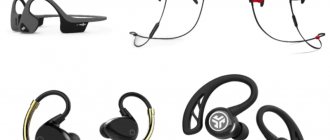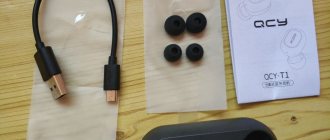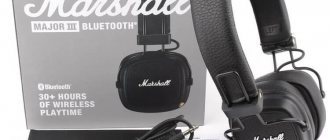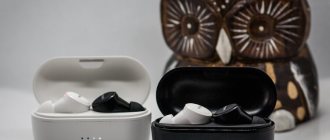The inexplicable ability of headphone wires to tangle in the user’s pocket into a tangle has already been the subject of many memes. When you take such a ball out of your pocket again, it’s wildly annoying. While untangling the wires in frustration, you can tug on one of them too hard and the headphones will end up in the trash.
Fortunately, manufacturers were able to offer an alternative to wired “plugs” - headphones-player. What are headphones with a player and what are their advantages and disadvantages, says a Sony Walkman WH505 user with 8 years of experience.
What are headphones-player?
Headphone-player is a predominantly closed-type gadget with a slot for a flash card. The ability to replace the memory card depends on the design features of the headphones. On some models it cannot be replaced without completely disassembling the gadget. In this case, you can only download new tracks and delete boring ones via a USB cable.
Tracks are controlled through keys and toggle switches located on the earcups. For example, after a short press on the toggle switch, the next song in the list starts playing, and after a long press, the next album in the list starts playing. You can also adjust the volume, activate another equalizer preset or Shuffle mode - play tracks in a random order.
Despite the fact that some users on the Internet claim that the player headphones sound bad, this is not the case. This “rumor” is the product of a “damaged phone”, and it is most actively spread by those who have had nothing to do with headphones with built-in players at all. In any case, the player headphones have a 3.5 mm jack, so you can connect them to your phone via an AUX cable.
Advantages and disadvantages
Here are a number of reasons why users love headphones with a built-in player:
- Long working time. For some reason, people are amazed when you tell them that the player headphones need to be charged once every 2 weeks. But this is actually true. If you charge the ears before the trip, you don’t have to take the power cable with you. On average, one charge lasts for 12 hours of music playback.
- No wires. Listening to headphones while jogging is pure pleasure. Running with a heavy 6-inch smartphone dangling in your shorts pocket is such a pastime.
- There is a radio. If you're tired of your playlist, you can switch to a trendy radio station and get acquainted with the latest music. However, not all players are equipped with an FM radio function.
Headphones with a player have features that manufacturers should think through more carefully:
- Track navigation. Finding the track you want to listen to in a playlist on your smartphone is as easy as shelling pears. But with headphones-player the situation is different. Using the switch you can go to the next/previous song or next/previous album. If there are 40 more tracks between the song you just listened to and the song you want to listen to next, you will have to press the switch 40 times.
- Weight. Player headphones are heavier than regular ones because they have a “filling” - a microprocessor, a flash drive, and a battery. On average, the weight is about 250-300 grams.
- Maintainability. Alas, for many models - including the Sony Walkman WH505 headphones, which the author absolutely adores - the flash drive cannot be removed. So, if the gadget suddenly fails, you will have to contact a service center for diagnostics. Although, perhaps, such a banal operation as replacing a memory card would allow the user to return the player to a working state without extra costs.
Choosing a player for your ears
In addition to paying due attention to the analysis of basic indicators, it is important to consider special points related specifically to wireless headphones with a player:
- memory;
- working hours;
- reproducible formats;
- weight.
Memory in choosing an accessory of this type should be a decisive indicator. The number of music tracks that can “fit” on the built-in flash card, as well as the “speed” of the device, directly depends on its volume. When purchasing headphones with extremely limited memory, the user must be prepared to regularly update the playlist or listen to a “loop” audio stream for extended periods. Manufacturers offer products with a built-in flash drive up to 32 GB, so choosing the largest number will be the most correct in this case.
The battery life of the device is no less important characteristic, which has a direct impact on the completeness of receiving positive emotions from using “ears” with a built-in player. An ideal accessory would require “recharging” once every 12 hours. Analogs with a battery capacity of 6-8 hours are inferior in comparison with the above option, due to the high probability of unforeseen situations with an absolute discharge of the battery at the wrong time.
Top-end “ears” with a player and radio inside reproduce a huge number of formats, rarely found in practice. When choosing an accessory, a potential buyer should make sure that it is possible to play tracks of the most popular type - MP3, WMA, Apple Lossless. In all other cases, the desired track can be easily formatted into the required form by using special programs that are freely available.
The weight of the design of headphones with an mp3 player is interdependent with the convenience of their use, especially during sports or a long trip. A heavy accessory will cause significant discomfort to the user, over time beginning to “pull” the ears or put pressure on the temples, and in some cases even cause pain in the head and cervical region. To avoid such situations, a potential buyer is recommended to choose a device weighing no more than 30-40 g.
Having settled on one or several specific models, the user should analyze the ratio of frequently encountered positive and negative aspects of using products in the segment in question.
Advantages of using wireless headphones with a player:
- ease of use due to the absence of wires;
- ergonomics of most models;
- fast charging;
- the ability to “calibrate” the sound;
- the absolute majority of “representatives” of the segment in question have the property of protection from moisture and dust.
Disadvantages of using wireless headphones with a player:
- loss of sound quality in comparison with wired or wireless “competitors”;
- limited memory capacity;
- the heavy weight of some models of accessories, which causes discomfort.
What types of wireless headphones-player are there?
Depending on the design, player headphones are divided into full-size or closed-type (left) and sports (right).
In sports headphones, the emphasis is on compactness. They weigh like a feather, but sound rather mediocre. A person who is accustomed to the sound of full-size headphones will listen to sports headphones through pain. Note that sports headphones are not independent - they operate on a battery for 7-8 hours.
Full-size headphones usually have a phenomenal frequency range. Sony Walkman models, for example, transmit frequencies from 5 Hz to 25,000 Hz - and this despite the fact that a person hears a range of 16-20,000 Hz. You can run in closed-type headphones; their weight does not cause much discomfort when they are on your head. But if you want to take a break and listen to the sounds of the street while jogging, then hang them around your neck - then the cups will hit your chest unpleasantly.
Closed-back player headphones are a rather fragile thing. We recommend that you protect your gadget from falls and impacts in every possible way. Sports headphones, on the other hand, are durable.
Player headphones are also classified according to the presence of FM radio, Bluetooth support, and degree of protection from water. However, these functions are perhaps self-explanatory.
Top headphones with built-in player
Sony Walkman NWZ-W273
pros
- waterproof case
- weight
- good ergonomics
- reliable battery
- "extended" package
Minuses
- poor build quality
- insufficient amount of low frequencies
- low noise reduction
From 3190 ₽
Ideal for use in the pool, thanks to their water resistance and tight “fitting” in the ears, which does not limit the swimmer in the elements performed.
Perfeo VI-M014
pros
- acceptable sound quality
- presence of built-in FM radio
- affordable price
Minuses
- low noise reduction
- short battery life
- lack of instructions in Russian
From 1125 ₽
A good budget accessory with pleasant sound transmission and high-quality ergonomics for long-term use.
ALCOM WP-800
pros
- high quality waterproof
- good ergonomics
- "extended" package
- long battery life
Minuses
- quiet sound played
- loose attachment of attachments
From 3850 ₽
Excellent accompaniment for sports activities, satisfying the basic needs of “athletes”.
Perfeo VI-M015
pros
- affordable price
- ease of use
Minuses
- poor build quality
- high level of susceptibility to magnetic interference
- there is no option to “rewind” a track
- poor ergonomics
- non-compliance with the declared characteristics - water resistance
From 900 ₽
Ideal for listening to music for a short time, for example, on the way to work. An excellent combination of cost and basic characteristics of headphones in this price category.
How to choose headphones with a player?
A person who is not demanding on sound quality and who, for example, listens to music to concentrate on work, can afford to choose headphones based on their appearance. But a music lover needs to understand the technical characteristics and choose headphones based on them. Otherwise, an expensive purchase may result in disappointment.
What you should definitely look for:
- Sensitivity. Contrary to popular belief, it is sensitivity that determines the volume of headphones, not power. The norm is a “corridor” of 90-120 dB.
- Impedance. Impedance (resistance) is the inverse parameter of sensitivity. For headphones, the norm is 16-40 dB, the average value is 32 dB.
- Power. The power value is not the most important thing now, because modern headphones have amplifiers. Thanks to amplifiers, even with minimal power you can get decent sound. Here we recommend focusing on a wide “corridor” of values – 50-100 mW.
- Frequency range. The frequency range of 20-20000 Hz is sufficient. A person hears lower frequencies only under ideal conditions and up to a certain age.
- Memory size. You can ignore this parameter if the headphone player has the ability to replace a flash drive. If not, it’s better to go with 16 GB. However, your music lover author failed to fill this volume even halfway.
- Autonomy. The operating time of the models is very different: some work 40 hours without recharging, others only 7. It’s difficult to advise anything here, because it’s important to imagine how often and for how long a music lover listens to music. Autonomy of 20 hours is more than a decent indicator. You can listen to headphones for an hour a day for 3 weeks. By the way, when turned off, they almost do not lose charge.
- Weight. Closed-back headphones should weigh up to 300 grams so that you can use them without discomfort. Sports headphones typically weigh about 30 grams.
Design is also important. It was love at first sight for the author of this article with the Walkman WH505 model - it was impossible not to fall in love with the headphones placed on a special Sony branded stand with backlight. For its excellent design, the Japanese player would have to forgive shortcomings in sound - if they existed, of course.
What to look for when choosing
Wireless headphones with a player have a microprocessor and a memory card. You can download music to the built-in flash drive via Bluetooth and listen at any time without the help of other devices. An important fact about the player is the format of the music. But the technical characteristics of the device are also important, because they provide loud, clear sound. When purchasing, the following parameters are important:
- Sensitivity. The higher the values, the louder the music will sound. Normal values are from 90 to 120 dB.
- Impedance or resistance. Affects volume and sound quality. Optimal values are in the range of 16-60 Ohms.
- Power. Here the principle “the more the better” does not apply. Modern models have a built-in amplifier, which allows you to get high-quality sound with minimal power without needlessly discharging the battery. 50-100 mW is enough.
- Frequency range. Determines how voluminous and detailed the sound will be, what sounds you can hear. Our hearing aids only detect sounds in the range from 20 to 20,000 Hz. But if you take into account the frequency response, then at the edges of these values there may be a decline; as they say, low or high frequencies are cut off. Therefore, it makes sense to choose ears with a range from 16 to 25000 Hz, with a small margin.
Now let's look at the parameters important for the player:
- Memory. The capacity of a built-in or plug-in flash drive is needed to record tracks and operate the processor. The more memory, the larger your audio library. Wireless headphones with a built-in player use options up to 32 GB. Personally, I think too much memory is unnecessary. At every stage of our lives, we listen to a certain amount of pretty music. For 200-300 tracks in MP3 format with a bitrate of 320 kbit/s, 2 GB of memory is enough.
- Autonomy. If you listen to music from the built-in player, rather than via Bluetooth, the battery drains much more slowly. Typically, the manufacturer indicates the operating time for each use case - talking, wireless signal transmission, playing music from a flash drive. Miniature devices can sing for up to 8-10 hours, and full-size ones set records - more than a day. As a rule, the more capacious the battery, the more expensive, heavier and larger the device.
- Audio file format. Today, the wireless headphone player supports almost all known formats. In fact, the most common and in demand are WMA, MP3, Apple lossless.
- Ease of use. Comfort is determined by the weight and how the structure sits. It is better to make the choice through fitting, since the size and structure of the head and ears are individual. Even large and heavy devices can be very comfortable due to the correct weight distribution and optimal compression of the head.
And don't forget to evaluate the build quality. Gaps, cracks, dents, creaks, rattling inside indicate that the headphones were assembled in a clumsy manner and it’s somehow strange to expect long-term and high-quality work from them. Today, even Chinese plugs for 100 rubles look perfect.
Additional features:
- microphone for use as a headset;
- aux in connector for wired connection to a PC, laptop, smartphone or other player;
- water resistance is used in sports headphones, some can even be used for diving;
- radio;
- voice assistant, etc.











